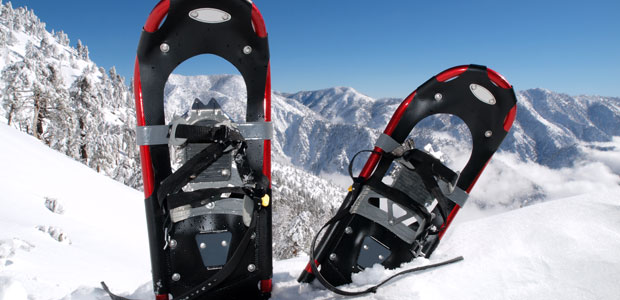
Snowshoeing has come a long way since the days of classic wooden-framed models. Read on to learn how to jump on board this famed winter sport!
Get the gear
Modern snowshoes are made of durable fabrics, and lightweight aluminum or plastic alloys make up the decks and frames. Recent models have a spring-loaded system that snaps the snowshoes back to your feet after each step.
While modern versions are skinnier than classic models—and are less awkward to use—one rule still applies: the larger the deck (base) the more flotation you’ll have in the snow.
Most modern brands also come with prongs beneath the balls of the feet and heels, or along the edges. Heel prongs are useful for descending hills, while teeth along the edges are essential for traversing sideways up an incline.
Learn the ropes
Turning around and getting up after a fall are basic skills you’ll need to learn from the start. The easiest way to get up is to roll onto your front and push yourself into a kneeling position. From your knees you can then use your arms to push yourself back up to your feet. Ski or hiking poles can be useful in this situation.
To turn around, use what is called the step turn. Lift one shoe and place it at a 90-degree angle in front of the other (forming a T with your feet). Then shift your weight and bring the other snowshoe alongside. Do it again to make the full turn.
Ascending, descending, or traversing hills on snowshoes require more advanced techniques. On moderate hills keep your feet pointing straight ahead, and as you step up, transfer your weight onto the front of your uphill snowshoe to create traction.
When descending, weight the heel of your foot as you step down. On steeper inclines you may need to kick more aggressively into the slope and then stamp your feet a few times to create a solid platform before finishing the step.
Health benefits
If you don’t like going to the gym during the cold season, it can be difficult getting enough exercise. A recent study found that breaking trail over flat and varied terrain at about 5 km per hour burns calories at a rate similar to people who run at 10 km per hour or cycle at 25 km per hour.
Exercising in the cold is also a great way to lose weight because our bodies burn more calories just staying warm.
Safety first!
Beginners may venture into mountainous terrain where avalanche hazards pose a serious problem. If you’re planning to travel in the backcountry, you’ll need to attend an avalanche course, carry the proper rescue equipment, and know how to use it.
Daytime temperatures can plummet rapidly during the winter months. Always travel with a partner and make sure to leave enough time to return to your vehicle before dark.
Snowshoeing opens up countless options for getting outdoors during the winter months. Try it once and you might just get hooked.
Related Articles
- Shape up for Winter Sports
- Cheap Winter Thrills




































